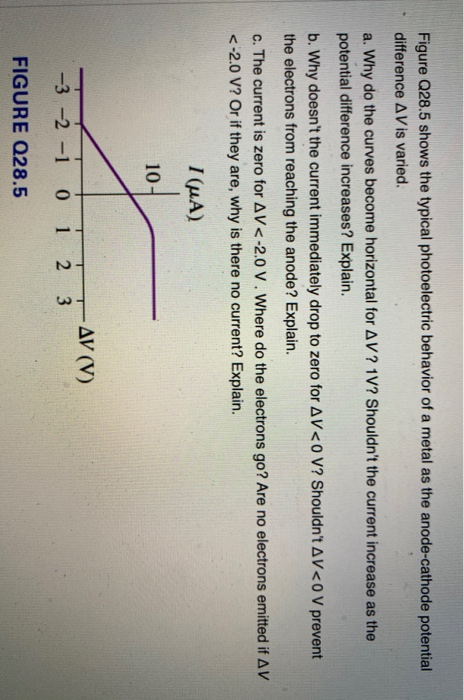3) Figure Q28.5 shows the typical photoelectric behavior of a metal as the anode-cathode potential difference AVis varied. a. Why do the curves become horizontal for AV? 1V? Shouldn't the current increase as the potential difference increases? Explain. b. Why doesn't the current immediately drop to zero for AV<0 V? Shouldn't AV<0V prevent the electrons from reaching the anode? Explain. c. The current is zero for AV<-2.0 V. Where do the electrons go? Are no electrons emitted if AV <-2.0 V? Or if they are, why is there no current? Explain. I (µA) 10 AV (V) -3 -2 -1 0 1 2 FIGURE Q28.5
3) Figure Q28.5 shows the typical photoelectric behavior of a metal as the anode-cathode potential difference AVis varied. a. Why do the curves become horizontal for AV? 1V? Shouldn't the current increase as the potential difference increases? Explain. b. Why doesn't the current immediately drop to zero for AV<0 V? Shouldn't AV<0V prevent the electrons from reaching the anode? Explain. c. The current is zero for AV<-2.0 V. Where do the electrons go? Are no electrons emitted if AV <-2.0 V? Or if they are, why is there no current? Explain. I (µA) 10 AV (V) -3 -2 -1 0 1 2 FIGURE Q28.5
Modern Physics
3rd Edition
ISBN:9781111794378
Author:Raymond A. Serway, Clement J. Moses, Curt A. Moyer
Publisher:Raymond A. Serway, Clement J. Moses, Curt A. Moyer
Chapter3: The Quantum Theroy Of Light
Section: Chapter Questions
Problem 42P
Related questions
Question
Figure Q28.5 shows the typical photoelectric behavior of a metal as the anode-cathode potential difference ΔV is varied.
a. Why do the curves become horizontal for ΔV ? 1V? Shouldn’t the current increase as the potential difference increases? Explain.
b. Why doesn’t the current immediately drop to zero for ΔV < 0 V? Shouldn’t ΔV < 0 V prevent the electrons from reaching the anode? Explain.
c. The current is zero for ΔV < -2.0 V . Where do the electrons go? Are no electrons emitted if ΔV < -2.0 V? Or if they are, why is there no current? Explain.

Transcribed Image Text:Figure Q28.5 shows the typical photoelectric behavior of a metal as the anode-cathode potential
difference AVis varied.
a. Why do the curves become horizontal for AV? 1V? Shouldn't the current increase as the
potential difference increases? Explain.
b. Why doesn't the current immediately drop to zero for AV<0 V? Shouldn't AV<0V prevent
the electrons from reaching the anode? Explain.
c. The current is zero for AV<-2.0 V. Where do the electrons go? Are no electrons emitted if AV
<-2.0 V? Or if they are, why is there no current? Explain.
I (µA)
10
AV (V)
-3 -2 -1
1
2
FIGURE Q28.5
Expert Solution
This question has been solved!
Explore an expertly crafted, step-by-step solution for a thorough understanding of key concepts.
This is a popular solution!
Trending now
This is a popular solution!
Step by step
Solved in 2 steps

Knowledge Booster
Learn more about
Need a deep-dive on the concept behind this application? Look no further. Learn more about this topic, physics and related others by exploring similar questions and additional content below.Recommended textbooks for you

Modern Physics
Physics
ISBN:
9781111794378
Author:
Raymond A. Serway, Clement J. Moses, Curt A. Moyer
Publisher:
Cengage Learning

Principles of Physics: A Calculus-Based Text
Physics
ISBN:
9781133104261
Author:
Raymond A. Serway, John W. Jewett
Publisher:
Cengage Learning

University Physics Volume 3
Physics
ISBN:
9781938168185
Author:
William Moebs, Jeff Sanny
Publisher:
OpenStax

Modern Physics
Physics
ISBN:
9781111794378
Author:
Raymond A. Serway, Clement J. Moses, Curt A. Moyer
Publisher:
Cengage Learning

Principles of Physics: A Calculus-Based Text
Physics
ISBN:
9781133104261
Author:
Raymond A. Serway, John W. Jewett
Publisher:
Cengage Learning

University Physics Volume 3
Physics
ISBN:
9781938168185
Author:
William Moebs, Jeff Sanny
Publisher:
OpenStax